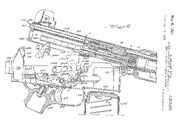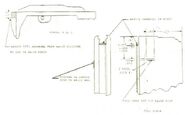The ArmaLite AR-18 is an assault rifle chambered for 5.56x45mm NATO ammunition. The AR-18 was designed by Arthur Miller, George Sullivan, and Charles Dorchester at ArmaLite in 1963 as an improved 5.56 mm caliber alternative to ArmaLite's previous AR-15 design, for which production rights had been sold to Colt Manufacturing Company. ArmaLite's interest in the design waned when the Colt AR-15 was selected for production by the US Army as the M16.
History
Trials
- Main article: 1955 US Army Gun Trials
The US Army was holding trials for a battle rifle to replace their M1 Garands with a new weapon capable of fully automatic fire. The new weapon was intended to either fully or partially replace the M1 Carbine, Browning Automatic Rifle (BAR), and M3 Submachine gun as well. The US Army was against any reduction in power in their new weapon despite arguments that the full power round was not suitable for automatic fire and through their dominant position a slightly shorter version with similar power to their current rifle round became the standard 7.62x51mm NATO round. Springfield Armory and Fabrique Nationale both entered designs based on fairly conventional engineering; the M14 was selected. This rifle replaced the Garand, but was essentially a product-improved M1 Garand.
Post-Trial
Only two years later, the US Army was once again looking for a new rifle, this time based on a much smaller .223 caliber round and lighter in weight. This time, ArmaLite was invited to compete right from the start, and responded with a smaller version of the AR-10, the AR-15. Winchester Arms submitted a remake of a 'Carbine' Williams prototype carbine, and Springfield Armory was forbidden to participate, as senior Ordnance Corps officials had not yet accepted the small-caliber, high-velocity concept.
In the end the Army selected the AR-15, as the M16, as their new standard rifle. This was not without further controversy, especially early reports of problems with the gas system fouling. Although these problems were later traced to changes in the ammunition and an almost complete lack of cleaning in the field, it was often used as evidence against the weapon itself. During the protracted acceptance trials (which took several years) ArmaLite had essentially given up, and sold the AR-15 production license to Colt.
After selling the design, ArmaLite began the development of two new rifles based on a modified action that no longer used a expanding gas piston action. The AR-16 was a 7.62 mm rifle similar to the AR-10, and the AR-18 was its 5.56 mm counterpart. The design of the AR-18 is mainly credited to ArmaLite's chief designer at the time, Arthur Miller.
Overall, the new designs were much more conventional than previous ArmaLite designs. They were immediately criticized for their appearance. At the time, crude sheet metal and welded components were frowned upon in the use of service rifles. However, such construction proved to be a sign of things to come, as it promised significantly reduced production costs, and allowed it to be made on less advanced machinery.
Key to the cost reduction was the use of stamped-metal receivers and other components, as opposed to the AR-10/15's forged aluminum receiver. In addition a simpler operating system with a conventional piston rod was selected in place of the lightweight gas tube and cutoff used in the earlier AR-15, intended to address complaints about reliability and fouling. The bolt, springs and recoil buffer were housed within the receiver, and the bolt rode on two metal rods instead of the receiver walls, which provided additional clearance for dust and mud. Compared to the AR-15, which housed its buffer mechanism in the buttstock, the AR-18's compact design enabled the use of a folding stock with a hinging mechanism (that later proved to be less than adequately rigid).
Production
The Armalite AR-16 design never progressed beyond prototype stage, but the AR-18 was put into limited production, and underwent testing as an alternative to the AR-15. At this point, however, the AR-15/M16 rifle had been fully developed, flaws had been ironed out in successive modifications, and the U.S. military was not interested in acquiring yet another 5.56 mm service rifle. A semi-automatic version of the AR-18 design known as the AR-180 was later produced for the civilian market between 1969 and 1972 at Armalite's Costa Mesa manufacturing plant. The Costa Mesa AR-180s were one of the first military-type semi-automatic rifles to become widely available in the USA. Howa, of Nagoya, Japan continued production of the AR-18/AR-180 from 1972 until 1974, but the Japanese government later forbade them to make war weapons, and production was discontinued. Sterling in the UK produced the AR-18/AR-180 from 1979 to the 1985. Parts from the AR-18 were used in the British forces' SA80, and the Singaporean SAR-80.
Many UK-made Sterling rifles were purchased by IRA sympathizers, and found their way into the hands of the Provisional IRA, where the rifle was known as the "widowmaker". The ArmaLite rifle was for many years the most lethal weapon available to the PIRA. For this reason it become an iconic symbol within that movement. The republican ballad Little ArmaLite tells of how the AR-18 changed the fortunes of Republicans in their confrontation with British state forces. The 1980s Republican political strategy of parallel political and paramilitary campaigns was also christened the "ArmaLite and ballot box strategy".
Unlike the AR-15/M16, the AR-18 did not see substantial improvement, and was not adopted in large numbers by any military service. In the end, the commercial failure of the AR-18 was not due to any significant flaws in its basic design, but in the lack of marketing efforts by ArmaLite. In 1968, dissatisfied with the way ArmaLite had marketed the AR-18, Arthur Miller left ArmaLite.
ArmaLite offered a modernized version of the AR-180, called the AR-180B, in 2001. This one differed from the original being made mostly out of polymers, and accepting STANAG magazines. A common criticism was that the gun was inferior compared to its original design, and the lower polymer receiver was prone to cracking. In 2008, ArmaLite dropped the rifle due to lackluster sales.










